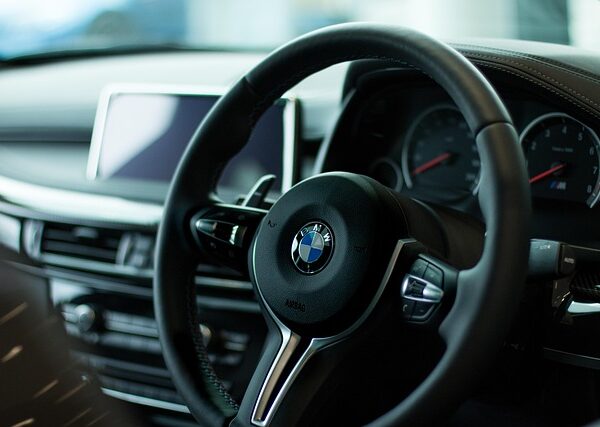In-Car Infotainment: Revolutionizing the Driving Experience
Introduction
Welcome to an in-depth exploration of a technology that is transforming the way we travel: In-Car Infotainment. This comprehensive guide aims to delve into every aspect of this innovative system, from its fundamental components to its global impact and future prospects. By the end of this article, readers will have a thorough understanding of In-Car Infotainment, its role in modern automotive culture, and the many ways it enhances our daily commutes.
Understanding In-Car Infotainment: A Definition and Its Components
Definition: In-Car Infotainment, short for in-vehicle entertainment and information system, is an integrated technology package designed to enhance the driving experience through various multimedia and communication functions. It goes beyond basic navigation by offering a wide array of features tailored to entertain, inform, and connect drivers and passengers while on the road.
Core Components:
-
Touchscreen Interface: The centerpiece of In-Car Infotainment is often a large touchscreen display, serving as the primary control and interaction point for users. These screens support gesture controls, voice commands, and intuitive menus.
-
Audio and Visual Systems: High-quality audio systems with surround sound capabilities are essential. Modern infotainment systems also include advanced video displays, allowing for media playback, navigation maps, and rear-seat entertainment.
-
Navigation and GPS: Built-in GPS modules provide real-time location data, enabling accurate turn-by-turn navigation. These systems can offer traffic updates, route optimization, and points of interest (POI) information.
-
Connectivity: In-Car Infotainment systems are designed to connect vehicles to the internet, supporting features like wireless streaming, smartphone integration via Apple CarPlay or Android Auto, and over-the-air software updates.
-
Voice Assistants: Artificial intelligence-powered voice assistants have become integral, allowing users to control various functions hands-free through voice commands. Popular examples include Amazon Alexa, Google Assistant, and Siri.
-
Apps and Content Access: Users can access a wide range of applications, from streaming music and podcasts to online radio, social media, and gaming. Some systems even offer over-the-air content updates.
Global Impact and Trends: A World-Wide Revolution on Wheels
In-Car Infotainment has left an indelible mark on the global automotive landscape, with adoption rates varying across regions. Here’s a glimpse into its international influence:
| Region |
Adoption Rate (%) |
Trending Features |
| North America |
78% (2021 data) |
Advanced driver-assistance systems (ADAS), voice control, integration with wearable devices |
| Europe |
65% |
High focus on sustainability and environmental info, robust mapping services |
| Asia-Pacific |
55% |
In-car gaming, local language support, advanced cybersecurity measures |
| Latin America |
48% |
Affordability, basic navigation, radio integration |
Trending Features Globally:
- Voice Control and AI Assistants: The use of voice commands is on the rise worldwide, driven by advancements in natural language processing.
- Sustainability Focus: Many regions are incorporating eco-friendly practices, displaying fuel efficiency data, electric vehicle (EV) charging station maps, and environmental tips.
- Personalization: Users expect customized interfaces, with settings tailored to individual preferences.
- Integration with Wearables: In-car systems can now sync with fitness trackers and smartwatches for health-related updates.
Economic Considerations: A Driving Force for Growth
The economic implications of In-Car Infotainment are significant, impacting both the automotive industry and the broader digital ecosystem.
Market Dynamics:
- Hardware Sales: The global market for in-car infotainment hardware is projected to reach $17.5 billion by 2026, growing at a CAGR of 13.2% (2021-2026).
- Software and Services: This segment dominates the market, expected to exceed $29 billion by 2027, driven by subscription services, app downloads, and content licensing.
- Vehicle Manufacturers: In-Car Infotainment is becoming a key differentiator for automakers, with premium brands offering advanced systems as standard or optional features.
Investment Patterns:
- Automotive Industry: OEMs (Original Equipment Manufacturers) are investing heavily in R&D to develop and integrate infotainment systems seamlessly into vehicles.
- Tech Companies: Major tech firms like Google, Apple, and Amazon are partnering with automakers to provide software solutions, ensuring their technology is built into new cars.
- Startups: Newer companies are focusing on innovative hardware designs and unique user experiences, targeting specific niches in the market.
Technological Advancements: Pushing the Boundaries of In-Car Experience
The realm of In-Car Infotainment has witnessed remarkable technological leaps, shaping its current capabilities and future potential.
Recent Developments:
- 5G Connectivity: The rollout of 5G networks promises faster data speeds, enabling seamless streaming, quicker map updates, and enhanced voice and video calls.
- Advanced Driver Assistance Systems (ADAS): Features like adaptive cruise control, lane departure warning, and automatic emergency braking are becoming more sophisticated, paving the way for autonomous driving capabilities.
- Cloud Integration: Cloud-based services allow for over-the-air updates, remote vehicle diagnostics, and real-time traffic data, enhancing system performance and user experience.
- Enhanced Voice Control: AI improvements have led to more accurate voice recognition, allowing users to control various functions with natural language commands.
Future Prospects:
- Autonomous Vehicles: In-Car Infotainment will play a pivotal role in self-driving cars, providing passengers with entertainment and information during automated journeys.
- Immersive Audio: Advanced audio technologies like Dolby Atmos and 3D surround sound are set to revolutionize in-car listening experiences.
- Artificial Intelligence (AI): AI algorithms can personalize content, anticipate user needs, and offer context-aware suggestions, creating a more intuitive and adaptive infotainment system.
- Augmented Reality (AR): AR navigation and interactive vehicle diagnostics could become commonplace, providing drivers with essential info in a visually enhanced manner.
Policy and Regulation: Navigating the Legal Landscape
The development of In-Car Infotainment is guided by various policies and regulations, ensuring safety, data privacy, and consumer protection.
Key Considerations:
- Safety Standards: Governments worldwide mandate that infotainment systems meet specific safety criteria, including emergency call functionality (eCall) and compliance with electrical/electronic engineering standards.
- Data Privacy: With increasing connectivity, regulations like the GDPR in Europe and the CCPA in California address user data collection, storage, and sharing practices.
- Radio Spectrum Allocation: Regulatory bodies manage the allocation of radio frequencies for infotainment systems, ensuring interference-free operation.
- Content Licensing: Laws govern copyright and intellectual property rights related to media content accessible through infotainment systems.
Regional Variations:
- North America: The U.S. National Highway Traffic Safety Administration (NHTSA) sets safety standards, while the Federal Trade Commission (FTC) oversees data privacy practices.
- Europe: The European Union’s General Data Protection Regulation (GDPR) provides a comprehensive framework for data protection and privacy.
- Asia: In China, the Ministry of Industry and Information Technology (MIIT) regulates telecommunications, including infotainment system standards. Japan has its own set of safety and data protection regulations.
Challenges and Criticisms: Overcoming Obstacles
Despite its numerous advantages, In-Car Infotainment faces several challenges and criticisms that require careful consideration and innovative solutions.
Main Issues:
- Safety Concerns: Distracted driving is a major worry, as users might be tempted to take their eyes off the road while interacting with infotainment systems. Addressing this requires robust safety features, driver-centric design, and user education.
- Data Privacy and Security: With constant connectivity, protecting user data from cyber threats and unauthorized access is essential. Encryption, secure data storage, and regular security updates are crucial measures.
- Compatibility and Standardization: The lack of uniform standards can lead to compatibility issues between different vehicle models and infotainment systems. Standardization efforts can ensure seamless integration and interoperability.
- Cost and Accessibility: Premium infotainment systems can be expensive, potentially creating a digital divide. Affordable options and accessibility features for all users are essential.
Strategic Solutions:
- Safety Features Integration: Collaborating with safety technology providers to incorporate advanced driver assistance systems (ADAS) directly into infotainment modules can enhance overall vehicle safety.
- Data Security Partnerships: Auto manufacturers should partner with cybersecurity experts to implement robust security protocols, ensuring data privacy and system integrity.
- Industry Collaboration: Establishing industry standards and collaborations between automakers, tech companies, and regulatory bodies can drive interoperability and innovation.
- Affordability and Inclusivity: Offering customizable packages and financing options, as well as developing accessible infotainment solutions for the elderly and disabled, can make these systems more inclusive.
Case Studies: Real-World Success Stories
Let’s explore a few case studies to gain insights into successful In-Car Infotainment implementations and the lessons learned from them.
Case Study 1: Tesla’s Autopilot and Enhanced Infotainment
Tesla, the electric vehicle pioneer, has raised the bar for in-car infotainment with its Autopilot system and over-the-air (OTA) updates.
- Features: Tesla’s Autopilot includes advanced driver assistance features like traffic-aware cruise control, automatic lane changes, and parking assist. The company’s OTA updates enable new functionality, improved safety, and software enhancements without requiring a trip to the dealership.
- Success Factors: Tesla’s success lies in its vertically integrated approach, allowing for tight hardware and software integration. Regular OTA updates keep vehicles current, ensuring drivers have access to the latest features.
- Lessons Learned: Continuous improvement through OTA updates fosters customer satisfaction and loyalty. A seamless user experience across hardware and software is crucial for long-term success.
Case Study 2: Toyota’s Entune 3.0 with Apple CarPlay
Toyota, a global automotive leader, has collaborated with Apple to offer the Entune 3.0 infotainment system in its vehicles.
- Features: Entune 3.0 integrates Apple CarPlay, allowing drivers to access their iPhone’s features and apps directly from the car’s display. It includes voice control, navigation, and Toyota’s Safety Connect emergency assistance.
- Success Factors: The partnership with Apple ensures broad appeal among iPhone users. The system’s ease of use, robust safety features, and integration with Toyota’s vehicle sensors make it a compelling choice for buyers.
- Lessons Learned: Collaborating with tech giants can accelerate market adoption and provide a competitive edge. Focusing on user experience and leveraging existing ecosystems are key strategies.
Case Study 3: Volvo’s Pilot Assist and Digital User Interface
Volvo Cars has implemented a comprehensive infotainment strategy, emphasizing safety and user-centric design.
- Features: Volvo’s Pilot Assist system includes adaptive cruise control, lane keep assist, and automatic emergency braking. The company’s digital user interface offers customizable displays, voice control, and Apple CarPlay/Android Auto integration.
- Success Factors: Volvo prioritizes safety as a core brand value, which aligns perfectly with its infotainment strategy. The intuitive design and focus on driver comfort create an enjoyable experience without compromising safety.
- Lessons Learned: Putting safety first while offering advanced features can build brand reputation and customer trust. A user-centric design philosophy ensures customer satisfaction and loyalty.
Future Prospects: Looking Ahead to the Next Horizon
The future of In-Car Infotainment is brimming with exciting possibilities, shaped by emerging technologies and evolving consumer expectations.
Growth Areas:
- Autonomous Vehicles: As autonomous driving technology matures, infotainment systems will become central to the passenger experience, offering entertainment, work, and relaxation during automated journeys.
- Immersive Technologies: AR and VR experiences integrated into vehicles could transform long-distance travel, providing interactive maps, games, and educational content.
- Personalized Content: AI algorithms can analyze user behavior and preferences to deliver tailored content, enhancing the overall infotainment experience.
- Voice Interaction: Advanced voice control systems will enable more complex conversations, allowing users to engage in natural language interactions with their vehicles.
Emerging Trends:
- 5G Connectivity: The widespread adoption of 5G networks will enable faster data transfer rates, enhancing streaming quality, map updates, and real-time communication.
- Cloud Integration: Vehicles will increasingly rely on cloud services for content delivery, vehicle diagnostics, and over-the-air updates, improving system performance and reducing hardware costs.
- Sustainability Focus: In-car infotainment will continue to highlight eco-friendly practices, providing drivers with fuel efficiency data, electric vehicle charging station maps, and tips for reducing their environmental footprint.
Strategic Considerations:
- Partnerships and Ecosystems: Automakers should foster partnerships with tech companies, content providers, and startups to create diverse and innovative infotainment solutions.
- Cybersecurity Enhancements: With increasing connectivity, automakers must invest in robust cybersecurity measures to protect against cyber threats and ensure data privacy.
- User Experience Design: Prioritizing user experience and accessibility will be crucial for keeping customers satisfied and engaged as infotainment systems evolve.
- Regulatory Compliance: Staying ahead of changing regulations, especially regarding data privacy and safety standards, is essential to avoid legal pitfalls.
Conclusion: Driving into the Future with Enhanced Infotainment
In-Car Infotainment has evolved from a simple navigation system to a complex ecosystem that entertains, informs, and connects drivers and passengers. Its global impact is undeniable, with automakers investing heavily in this technology and consumers embracing it for its convenience and entertainment value.
As we look ahead, the future of In-Car Infotainment promises exciting advancements, from autonomous driving capabilities to immersive AR/VR experiences. The continuous integration of cutting-edge technologies will shape a new era of connected and intelligent vehicles, revolutionizing how we travel.
By addressing challenges, leveraging partnerships, and prioritizing user experience, the industry can ensure that In-Car Infotainment remains a key differentiator in the competitive automotive market. This technology is not just about entertainment; it’s about enhancing our quality of life on the road.
Frequently Asked Questions (FAQs):
Q: How does In-Car Infotainment improve driver safety?
A: In-Car Infotainment systems can include advanced driver assistance systems (ADAS) like adaptive cruise control, lane departure warning, and automatic emergency braking. These features help reduce human error, enhancing overall vehicle safety.
Q: Can I use my phone with In-Car Infotainment?
A: Yes, many modern infotainment systems support Apple CarPlay and Android Auto, allowing you to access your smartphone’s apps and features directly from the car’s display.
Q: How do I keep my infotainment system secure?
A: Automakers should implement robust cybersecurity measures, including encryption, secure data storage, and regular security updates. Users can also enable vehicle-specific security features and follow best practices for online safety.
Q: What is the role of 5G in In-Car Infotainment?
A: 5G networks offer faster data transfer rates, enabling smoother streaming, quicker map updates, and enhanced real-time communication. This technology is crucial for future infotainment systems that rely on cloud connectivity and advanced multimedia content.
Q: How can I ensure my infotainment system remains up-to-date?
A: Over-the-air (OTA) updates are becoming common, allowing automakers to push software improvements and new features directly to vehicles without the need for a dealership visit. Regularly checking for updates ensures your system stays current.
Looking to register your car in California? This guide walks you through the step-by-step process, ensuring a smooth transition. From understanding the requirements for car registration in the Golden…….
Looking to register your car in California? This comprehensive guide breaks down the process step-by-step. From understanding key requirements to navigating various registration methods, you’ll learn…….
Registering a car in California is a straightforward process, but understanding the requirements and gathering the right documents is essential. This guide will walk you through each step, from ensuri…….
Looking to register your car in California? This comprehensive guide walks you through every step, from understanding essential requirements to securing your license plate. We break down the process i…….
Registering a car in California is a straightforward process, but it requires understanding specific rules and gathering essential documents. This guide walks you through every step, from meeting elig…….
Looking to register your car in California? This comprehensive guide walks you through the process step-by-step. First, understand the state’s unique car registration requirements and gather essential…….
Looking to register your car in California? This comprehensive guide breaks down the process step-by-step. From understanding eligibility requirements and gathering essential documents to verifying yo…….
Looking to register your car in California? This guide walks you through the entire process, from understanding state requirements to gathering essential documents and even using a DMV-approved VIN ve…….
Looking to register your car in California? This comprehensive guide walks you through the process step-by-step, ensuring a smooth transition. From understanding crucial registration requirements to p…….
Looking to register your car in California? This comprehensive guide walks you through every step, from understanding key requirements to obtaining your license plate. We cover crucial aspects like ga…….









